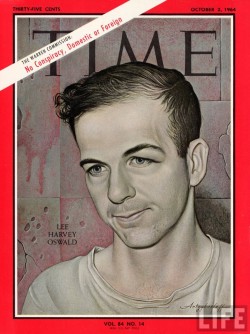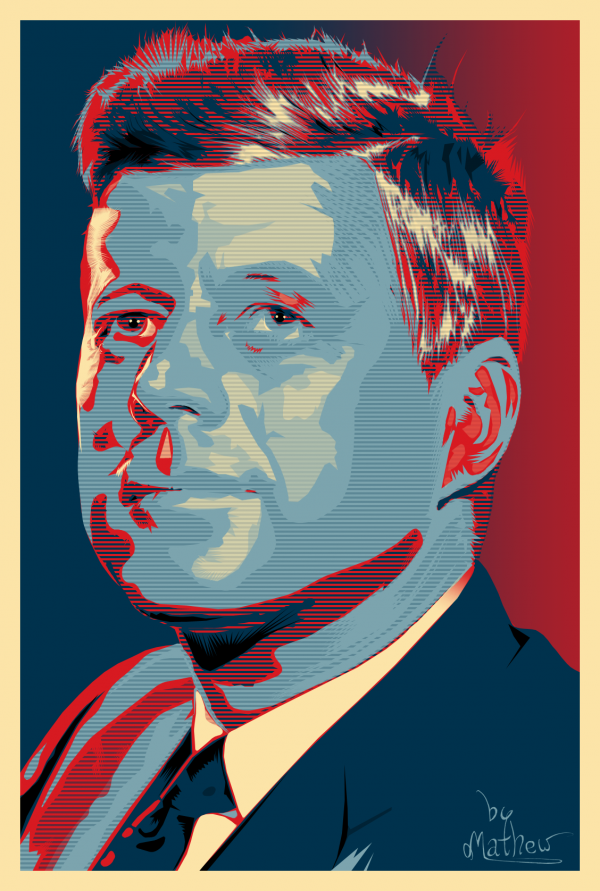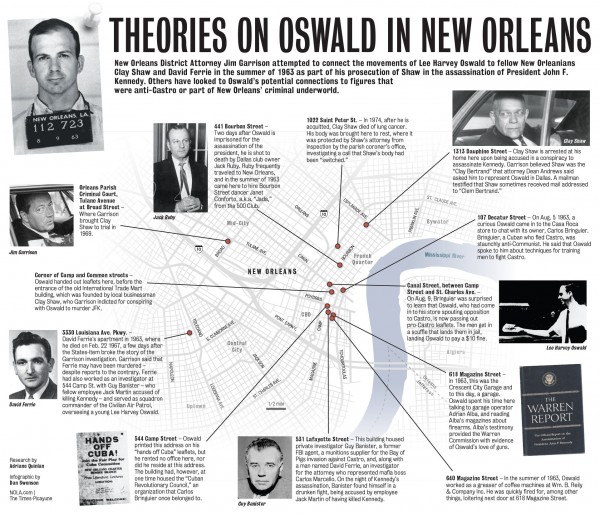NEW YORKER: Still, on this question, pending some further (and very belated) revelations, I’m willing to swallow my skepticism and accept the official story: Oswald was the lone shooter. But why did he do it, and was he maybe put up to it? It is here that the Secretary of State departs from the Warren Commission’s version of events. In an interview with NBC’s Tom Brokaw, Kerry said, “To this day, I have serious doubts that Lee Harvey Oswald acted alone.” And, he went on, “I’m not sure if anybody else was involved—I don’t go down that road with respect to the grassy-knoll theory and all that—but I have serious questions about whether they got to the bottom of Lee Harvey Oswald’s time and influence from Cuba and Russia…I think he was inspired somewhere, by something.”
Kerry isn’t the only one with unanswered questions about Oswald’s background. Almost certainly, we still don’t know all we might about his time in Russia, where he arrived as a defector in 1959; his interest in and support for the Cuban regime after his return to the United States; and his simultaneous links to people active in the anti-Castro movement, some of whom had connections to the mafia. “If you want to posit conspiracy, you must show associations,” G. Robert Blakey, a Notre Dame law professor who served as chief counsel to the House Select  Committee on Assassinations, said in a 1993 interview with Frontline. “And in his simple surroundings, such as David Ferrie”—a boyhood friend whom Oswald may have taken up with again after his return to the United States—“are people in both organized crime and with anti-Castro Cubans.”
Committee on Assassinations, said in a 1993 interview with Frontline. “And in his simple surroundings, such as David Ferrie”—a boyhood friend whom Oswald may have taken up with again after his return to the United States—“are people in both organized crime and with anti-Castro Cubans.”
There is also the unresolved question of how the C.I.A. may have been connected to Oswald, or, at least, how closely it was tracking his movements. In a letter to The New Yorker following the publication of Gopnik’s piece, Anthony Summers, a former BBC journalist who has written two books on the assassination, pointed out that more than seventeen hundred C.I.A. files pertaining to Oswald and the assassination remain classified. “If Oswald was a leftist loner who killed the President, and if that was all there was to it, why continue to conceal documents?” Summers asked.
The suspicion lingers that the Agency, for whatever reason, was monitoring Oswald more keenly than it has let on. But that’s far from the only, or even the main, reason for distrusting the official story. Frankly, I very much doubt that the Soviets, the Cuban government, or the C.I.A. hired Oswald to kill Kennedy. Maybe nobody did. But here’s another question that has always refused to vacate my mind when I’ve been about to close the casebook. If Oswald acted alone, without any outside influence, how and why did Jack Ruby pump a .38 slug into his gut two days later in the basement of the Dallas police headquarters? MORE
[Click HERE to enlarge]
SLATE: Fifty years after the assassination of President John F. Kennedy, 59 percent of Americans still believe it was the work of a conspiracy. I was once among them. Back in the early 1970s, as a high school senior and college freshman, I read Mark Lane’s Rush to Judgment, Richard Popkin’s The Second Oswald, Penn Jones’ Forgive My Grief, and other tomes, some of them best-sellers, that argued the case for a dark plot.Then, one day, I looked up the footnotes in those books, most of them leading me to the multivolume hearings of the Warren Commission. I was shocked. The authors had taken witnesses’ statements out of context, distorted them beyond recognition, and in some cases cherry-picked passages that seemed to back their theories while ignoring testimony that didn’t. It was my first brush with intellectual dishonesty. There’s no space to launch a full rebuttal of the conspiracy theorists. (It took 1,632 pages for Vincent Bugliosi to do that in his 2007 book Reclaiming History.) But it’s worth recounting the conspiracy buffs’ arguments that I found most persuasive—and why they collapse under scrutiny. MORE
NEW YORK TIMES: Before Nov. 22, 1963, Abraham Zapruder was an ordinary citizen of Dallas: a 58-year-old prosperous manufacturer of women’s clothing who had arrived in the city from Russia by way of Brooklyn. If that day had unfolded differently, that is most likely what he would have remained. But like a small but growing number of Americans at the time, he was also a home-movie hobbyist. With his receptionist, Marilyn Sitzman, as location scout and technical support, Zapruder took his 414PD Director Series Bell and Howell 8-millimeter camera to a spot on Elm Street, not far from his office, hoping to film the presidential motorcade as it drove past. The 26.6 seconds of footage he captured — 486 frames, without sound — inscribed Zapruder’s name in the official history and popular folklore of the John F. Kennedy assassination. Its images, blurry yet vivid, in color when almost all television and a great many movies were still in black and white, form part of what we know or think we know about what happened at Dealey Plaza. […] It is surely, frame by frame, the most closely studied, exhaustively analyzed film ever made, and also one of the most widely imitated. It has become, in spite of itself, an aesthetic object. Mr. Stone may have deployed the Zapruder film in “JFK” to clinch what he saw as the truth of his argument about who really killed Kennedy, but he succeeded in introducing a generation of moviegoers to its hallucinatory beauty.[…] The Zapruder film remains powerful partly because it seems to dwell in a zone of ambiguity that has become, over the years, a more and more familiar place. We accept it as true, without knowing what it means. Or, as Don DeLillo put it, referring explicitly, but surely not exclusively, to the Kennedy assassination: “We’re still in the dark. What we finally have are patches and shadows. It’s still a mystery.” MORE
THE PSYCLONE RANGERS: I Want To Be Jack Kennedy


